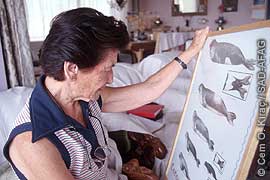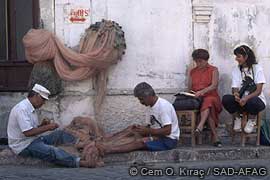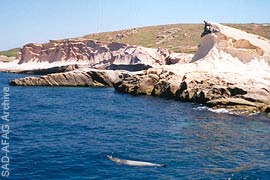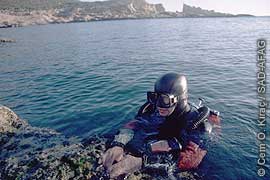

 |
||
 |
||
Vol. 7 (2): November 2004 |
Download this article
|
|
40 YEARS OF MONK SEAL CONSERVATION IN TURKEYCem Orkun Kiraç1, Yalçin Savas1 and Harun Güçlüsoy1,21. SAD-AFAG
|
 |
 |
|
|
Bahtiye Mursaloglu studying a monk seal poster in her Ankara home. |
Bahtiye Mursaloglu with fishermen in Foça. |
The important findings of Mursaloglu and Berkes, however, went virtually unnoticed by the broader public, by other academics and even by the responsible government departments, such as the Ministry of Forests (MoF) and the Ministry of Agriculture (MoA). Official permission for fishermen to kill dolphins in the Black Sea, for example, ignored the obvious vulnerability of the monk seals in the area, and the great risk of extermination they faced by these licensed “dolphin hunters”. Such short-sighted government decisions were taken despite Mursaloglu’s warnings in 1964 and despite IUCN’s inclusion of the species in the endangered red list in 1966. Indeed, monk seal slaughters continued until an official ban was imposed on the dolphin hunt in the Turkish Black Sea in 1980.
The most significant contributions by Berkes et al. (1979) were in determining the habitat, distribution and population of monk seals on the Black Sea, Aegean and Mediterranean coasts of Turkey, while also forming an analysis of threats according to region. Berkes also proposed the establishment of international marine parks between Turkey and Greece (Berkes 1978) while Mursaloglu (1984a, 1984b, 1984c, 1986 & 1991) provided substantial knowledge on the biology of the species including mother-pup relations, cave usage, and habitat requirements. Both stressed the importance and urgency of in situ protection.
November 1987 should be regarded as another milestone in the Turkish history of monk seal conservation, when representatives of the Mediterranean Seal Research Group (AFAG) and the Istanbul University Faculty of Aquatic Products (IU-FAP) met at the 3rd International Monk Seal Conference organized by Mursaloglu on behalf of Ankara University in Antalya. Ironically, this conference marked the end of Mursaloglu’s long professional career but coincided with the inaugural activities of AFAG (Kiraç & Bas 1999) and IU-FAP. Indeed, AFAG had been established only a month before the Antalya conference as a group within the Middle East Technical University Sub-Aqua Society in Ankara, a step triggered by Berkes through his invaluable guidance.
Despite retirement, Mursaloglu increased her contact with AFAG during the last years of her life and agreed to act as the scientific consultant of AFAG’s UNDP-GEF funded “BlackSeal” project, a commitment she maintained until her death in 1999 [see Obituary: Bahtiye Mursaloglu, 1918–1999, TMG 2 (1): May 1999].
Following its establishment, AFAG continued basic research and conservation activities with several short-term expeditions. The most prominent ones were carried out in the Dilek Peninsula National Park in February 1988, in Olimpos National Park in May 1988 and at the Black Sea in 1990. A “seal-fish farm interaction” survey, the first of its kind in Turkey, was also conducted at the Bodrum Peninsula in 1992. These initial and seriously under-funded field activities were conducted by only a handful of AFAG staff and volunteers, often using their own savings.
 |
 |
|
|
A monk seal off the Siren Rocks in the Foça Specially Protected Area. |
SAD-AFAG's Yalçin Savas during surveys in the Foça Specially Protected Area. |
Meanwhile, the efforts of AFAG and IU-FAP were bearing fruit in the press, with the publication of several popular articles drawing attention to the plight of the species. This, in turn, created a synergy among interested groups. In discussions with AFAG, Foça Municipality expressed a serious interest in becoming actively involved in the conservation of this rare marine mammal. Stemming from this dialogue, AFAG proposed the establishment of the National Monk Seal Committee (NMSC) and the adoption of a National Strategy to encourage a more coordinated approach to the conservation of the species. With the blessing of the Ministry of Environment, governmental departments, NGOs, universities and other interested parties were invited to attend the inaugural NMSC meeting in Ankara in January 1991. The meeting concluded by unanimously adopting a “National Strategy for the Conservation of the Monk Seal in Turkey”.
Fifteen NMSC meetings were held at more or less regular intervals between 1991 until 2001 and, during that 10-year period, Local Monk Seal Committees were also established, initially at Foça (1992) and Yalikavak (1993), and later at Aydincik and Karaburun. However, aside from Foça, none of these local committees have ever functioned adequately – due to an absence of outside support – in finding solutions for the conservation of the species and habitat protection; nor have they succeeded in introducing sustainable fisheries in their respective areas.
In June 1993, the Foça Pilot Project (FPP) commenced, with AFAG coordinating conservation efforts in the town funded with a grant from WWF. The initiative quickly generated interest and support among Foça locals and fishermen, The aims of the project were also reinforced with the provision of a patrol boat by the Ministry of Environment (MoE). The FPP yielded important results, not only in respect to determining the status of the species in Izmir Bay but also in developing experience in coastal and marine zone management planning. The project also developed a close working relationship with locals, artisanal fishermen, the Foça Municipality and the Foça Governorship.
Since then, AFAG has carried out numerous field expeditions, research initiatives and public awareness activities along Turkish coasts, mainly supported by organizations from abroad, including WWF (International, national offices and the Mediterranean Programme Office), UNDP-GEF, the Henry Ford European Conservation Awards, the European Commission, the Prince Bernhard Nature Conservation Fund, and the Van Tienhoven Foundation. National sponsors have included İS Bank and TUBITAK.
With the financial help of WWF and initial coordination by AFAG, the Middle East Technical University - Institute of Marine Sciences (METU-IMS) carried out research along the west Mersin stretch of Turkey’s Mediterranean coast from 1994 to 1997.
During this period, there were also attempts by NGOs to increase efficiency, influence and funding potential by taking united actions on behalf of the monk seal.
In 1989, AFAG’s written proposal for a collaborative agreement with DHKD (Turkish Society for the Protection of Nature), failed to elicit a positive reply. AFAG, however, went on to operate in an effective manner under SAD, established in 1994.
Later, in 1997, an attempt to establish a Turkish Monk Seal League among SAD-AFAG, the IU Faculty of Aquatic Products (IU-FAP) and METU-IMS also proved unsuccessful, and it quickly fell into a moribund state after just a couple of meetings.
A year later, at SAD-AFAG’s invitation, three METU-IMS monk seal conservationists joined forces with SAD-AFAG in order to spur coordinated and effective action on behalf of the monk seal. Although this collaborative effort produced clear and beneficial results during the first years, regrettably, the two organisations had already drifted apart by the end 2003. Whatever the precise causes of this estrangement, and without apportioning responsibility for it, there is little doubt that it has had a negative impact on the monk seal’s chances of survival in Turkey.
Despite the recent and tragic extinction of the species in the Black Sea, the Mediterranean monk seal continues to survive along Turkish coasts. Although time is not on conservation’s side, this is undoubtedly Turkey’s opportunity to demonstrate to its Mediterranean neighbours — most of which lost the species in the mid 1950s — that the monk seal can be saved. The opportunity is not only a chance to save a single species, but to preserve some of Turkey’s last unspoilt coastal zones. Given sufficient foresight, those who champion the monk seal cause in Turkey will also see the rewards in establishing well-managed marine protected areas, for the benefit and enjoyment of fishermen, tourists, local people and monk seals alike.
40 years have passed since the first modern scientific study was published on monk seals in Turkey and, in reviewing that period, we can list the following major achievements as well as weaknesses:
I. Research and acquiring scientific data
II. Sustainable management of aquatic resources
III. Conservation: protected areas and sustainable management plans
Concrete steps and achievements made during the third generation conservation period (since 1987) include:
IV. Public awareness and lobbying activities
V. Others
Beaufort, F. 1818. ‘Karamania’ or A Brief Description of the South Coast of Asia Minor and the Remains of Antiquity. R. Hunter, London.
Berkes, F. 1976. Monk Seals on the Southwest Coast of Turkey. Food & Agricultural Organisation, Advisory Committee on Marine Resources Research, Scientific Consultation on Sea Mammals, Bergen, Norway Doc. SC/109: 1-5.
Berkes, F. 1978. The possibility of movements of Monachus monachus between the coastal waters of Greece and Turkey. September 1978. Institute of Urban and Environmental Studies, Brock University, Ontario, Canada: 1-5 + 4 figs + 2 new figs.
Berkes, F., H. Anat, M. Esenel and M. Kislalioglu. 1979. Distribution and ecology of Monachus monachus on Turkish coasts. In: First International Conference on the Mediterranean Monk Seal (Eds., K. Ronald and R. Duguy), Rhodes Greece, 2-5 May 1978, Pergamon Press, Oxford, pp. 113-127.
Deveciyan, K. 1914. “Fish and Fishery”. Düyun-u Umumiye-i Osmaniye ve Varidat-i Mahsuse Idarei Merkeziyesi Matbaasi, Istanbul.
Güçlüsoy, H., G. Mo, Y. Savas and C. Sigismondi. 1999. Feasibility study for daily monitoring of a potential breeding cave for the Mediterranean monk seal Monachus monachus. The Monachus Guardian 2 (1): May 1999.
Güçlüsoy, H. and Y. Savas. 2003a. Interaction between monk seals Monachus monachus (Hermann, 1779) and marine fish farms in the Turkish Aegean and the management of the problem. Aquaculture Research 34: 777-783.
Güçlüsoy, H. and Y. Savas. 2003b. Status of the Mediterranean monk seal, Monachus monachus, in the Foça Pilot Monk Seal Conservation Area, Turkey. Zoology in the Middle East 28:5-16.
Güçlüsoy, H., C.O. Kiraç, N.O. Veryeri and Y. Savas. Status of the Mediterranean Monk Seal, Monachus monachus (Hermann, 1779) in the Coastal Waters of Turkey. In prep.
Karamanlidis, A.A. and W.M. Johnson (eds.). 2002. Annotated bibliography on Mediterranean monk seals (Monachus monachus). Version 1.0. The Monachus Guardian: 1-105. [![]() 366KB]
366KB]
Kiraç, C.O. 2001. Witnessing the extinction of monk seals in the Black Sea. The Monachus Guardian 4 (2): 2001.
Kiraç, C. and Y. Savas. 1996. Status of the monk seal (Monachus monachus) in the neighbourhood of Eregli, Black Sea coast of Turkey. Zoology in the Middle East 12: 5-12.
Kiraç, C.O., Y. Savas, H. Güçlüsoy and N.O. Veryeri. 1998a. Distribution and status of monk seal Monachus monachus (Hermann, 1779) along Turkish Coasts. Workshop on the Biology and Conservation of the World’s Endangered Monk Seals. 19-20 January 1998. Abstracts. pp. 50. The World Marine Mammal Science Conference, Monaco, 20-24 January 1998. The Society of Marine Mammalogy; the European Cetacean Society.
Kiraç, C.O., Y. Savas and H. Güçlüsoy. 1998b. Akdeniz Foku Monachus monachus; Önemi ve Türkiye’de Korunmasi. Booklet published under WWF Across the Waters Project “Seal-Info”, September 1998, Ankara.
Kiraç, C.O. and I.D. Bas. 1999. Bahtiye Mursaloglu - The monk seal looses a tireless campaigner and an influential friend. The Monachus Guardian 2 (1): 1999.
Kiraç, C.O., Y. Savas, H. Güçlüsoy and N.O. Veryeri. 2002, Observations on the diving behaviour of free ranging Mediterranean monk seals Monachus monachus on Turkish Coasts. The Monachus Guardian 5 (1): 2002.
Kompanje, E. J. O., H. Güçlüsoy and P.J.H. van Bree. 2000. Insufficient calcium intake as a possible cause of osteoporosis in an adult female monk seal Monachus monachus from Çesme, Turkey. The Monachus Guardian 3 (1): 2000.
Marchesseaux, D. 1987. The Mediterranean monk seal in Turkey. IUCN, Switzerland. Unpubl. ms., August 1987: 1-20.
Mursaloglu, B. 1964. Occurrence of the monk seal on the Turkish coasts. Journal of Mammalogy. 45 (2), 316-317.
Mursaloglu, B. 1984a. Monk seal conservation in Turkey. WWF Monthly Progress Report: 97-100.
Mursaloglu, B. 1984b. The survival of Mediterranean monk seal (Monachus monachus), pup on the Turkish coast. In: Second International Conference on the Mediterranean Monk Seal, (Eds. K. Ronald and R. Duguy), La Rochelle, France, 5-6 October 1984, Annales de la Société des Sciences Naturelles de la Charante-Maritime, France, pp. 41-47.
Mursaloglu, B. 1984c, Ege kiyilarinda son Akdeniz foklarinin Monachus monachus yasama sanslari, Symposium on Conservation of the Aegean Sea and Related Coasts, 28-29 November 1984, Izmir (in Turkish).
Mursaloglu, B. 1986. Pup-mother-environment relations in the Mediterranean monk seal, Monachus monachus (Hermann, 1779), on the Turkish coasts. Commun. Fac. Sci. Univ.Ank (C) 4:1-8.
Mursaloglu, B. 1991. Biology and distribution of the Mediterranean monk seal Monachus monachus on Turkish coasts. Council of Europe. Seminar on Conservation of Tech. Med. Monk Seal, Antalya, Turkey.
Öztürk, B., H. Erim, A. Çolak and U. Tali. 1991. Cruise results covering the period from 1987 to 1991 on the Mediterranean Monk Seal occurring along the Turkish Coastline. Council of Europe. Seminar on Conservation of Tech. Med. Monk Seal, Antalya, Turkey.
Öztürk, B. 1992. Akdeniz Foku Monachus monachus. Anahtar Kitaplar Yayinevi, Istanbul.
Salman, A., M. Bilecenoglu and H. Güçlüsoy. 2001. Stomach contents of two Mediterranean monk seals (Monachus monachus) from the Aegean Sea, Turkey. Journal of the Marine Biological Association of the United Kingdom. 81 (4): 719 - 720.
Savas, Y. 1999. How tourism has ruined the coastal habitats of the monk seal on the Bodrum Peninsula, Turkey. The Monachus Guardian 2 (2): November 1999.
Yediler, A., A. Panou and P. Schramel. 1993, Heavy metals in hair samples of Mediterranean monk seal (Monachus monachus). Marine Pollution Bulletin (26) 3:156-159.
Copyright © 2004 Cem Orkun Kiraç, Yalçin Savas, Harun Güçlüsoy, The Monachus Guardian. All Rights Reserved |